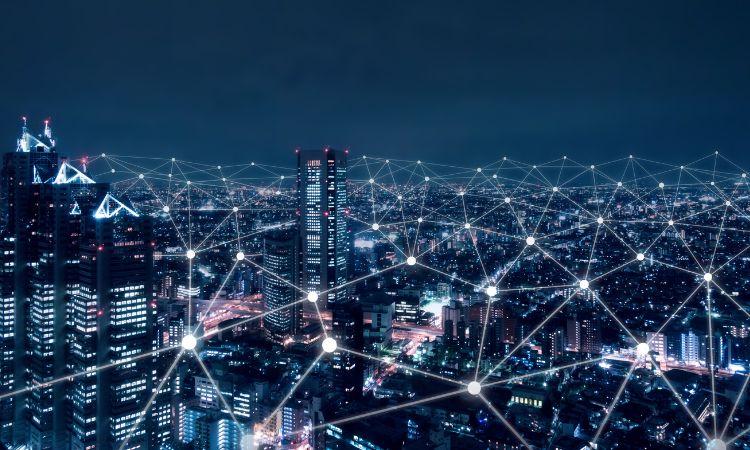The global IoT (Internet of Things) connectivity market is in the midst of a transformative journey, redefining the very fabric of our urban existence. In the year 2023, the IoT connectivity market size surged to an astonishing valuation of approximately USD 286.14 billion. What’s even more astounding is that the market is poised for continued expansion, projected to grow at an impressive CAGR (Compound Annual Growth Rate) of 20.2% between 2024 and 2032. By the time 2032 rolls around, it is forecasted to reach a staggering value of approximately USD 1499.24 billion. These numerical revelations serve as a testament to the far-reaching influence of IoT connectivity on our world, and nowhere is its impact more profound and promising than in the development of smart cities.
Smart cities, heralded as the pinnacle of urban evolution, are at the forefront of IoT connectivity adoption. In this comprehensive blog post, we will embark on an exploration of the multifaceted role that IoT connectivity plays in the context of smart cities. We will traverse the intricate landscape of infrastructure, applications, benefits, challenges, and future trends that collectively shape the urban landscapes of tomorrow.
IoT Connectivity Infrastructure in Smart Cities: The Bedrock of Transformation
Overview of IoT Devices and Sensors
The bedrock of any smart city transformation lies in the meticulous deployment of IoT devices and sensors throughout the urban environment. These technological sentinels, ranging from intelligent traffic lights to environmental sensors and surveillance cameras, collectively form the sensory nerve endings of the city, continuously collecting invaluable data.
Types of IoT Connectivity Protocols Used: Forging the Digital Nervous System
In the grand tapestry of IoT connectivity in smart cities, various protocols play crucial roles in ensuring seamless data transmission and communication. These include:
1. Cellular Networks (4G/5G): The Pinnacle of Speed and Connectivity
The advent of 5G networks has ushered in a new era for smart cities, characterized by low latency and high bandwidth, enabling real-time communication between devices. This, in turn, paves the way for transformative technologies such as autonomous vehicles and advanced healthcare systems.
2. LPWAN (Low-Power Wide-Area Network): The Quiet Revolution
Low-Power Wide-Area Network (LPWAN) technologies like LoRaWAN and Sigfox have carved out their niche in smart city applications. Their attributes include low power consumption and long-range capabilities, rendering them ideal for remote monitoring of assets and environmental conditions.
3. Mesh Networks: The Power of Redundancy
Mesh networks create a resilient, self-healing infrastructure where devices can seamlessly relay data through neighboring nodes. This inherent redundancy ensures robust connectivity, even in the face of challenging urban environments.
4. Satellite Connectivity: Reaching the Unreachable
Satellite connectivity, with its global coverage, emerges as an indispensable component for smart city applications that demand data transmission in remote or inaccessible areas.
Integration of IoT Connectivity Infrastructure with Existing City Infrastructure: Bridging the Digital Divide
One of the pivotal challenges in constructing smart cities lies in seamlessly integrating IoT connectivity with pre-existing infrastructure. Retrofitting aging infrastructure to harmoniously accommodate new technologies demands meticulous planning and substantial investment.
Applications of IoT Connectivity in Smart Cities: Transformative Possibilities Unleashed
IoT connectivity serves as the catalyst for a multitude of applications that elevate the quality of life for residents and catalyze sustainability in smart cities.
Smart Transportation: Navigating the Future
1. Traffic Management and Optimization: The Road to Efficiency
Smart traffic management systems leverage real-time data from sensors and cameras to orchestrate the seamless flow of traffic, thereby mitigating congestion and curbing emissions.
2. Public Transportation Monitoring: Empowering Commuters
IoT-enabled public transportation systems provide real-time information on bus and train schedules, enhancing commuter experiences and encouraging the use of public transport as a greener alternative.
Environmental Monitoring: Guardian of Well-being
1. Air Quality Monitoring: Breathing Easy
IoT sensors are strategically placed throughout the city to continuously monitor air quality. These sensors enable authorities to take immediate action in response to pollution spikes, safeguarding the health of residents.
2. Waste Management: Smarter Disposal
Smart waste bins, equipped with sensors, alert waste collection services when they require emptying. This not only optimizes collection routes but also reduces fuel consumption and environmental impact.
Public Safety: The Shield of Vigilance
1. Surveillance and Emergency Response: Vigilance Redefined
IoT-connected cameras and sensors bolster public safety by continuously monitoring for unusual activities and facilitating rapid emergency response when needed.
2. Predictive Policing: The Power of Data
Data analytics and machine learning algorithms play a pivotal role in predicting areas with a higher likelihood of crime, allowing law enforcement agencies to allocate resources more efficiently and prevent criminal activities.
Energy Management: Illuminating Efficiency
1. Smart Grids: A Symphony of Energy
Smart grids orchestrate the delicate balance between energy supply and demand, minimizing wastage and reducing the risk of energy shortages or blackouts.
2. Efficient Street Lighting: Shining Smartly
IoT-controlled streetlights adjust their brightness based on the presence of pedestrians or vehicles, conserving energy and curbing light pollution.
Healthcare and Wellness: Fostering Well-being
1. Remote Health Monitoring: Care at Your Fingertips
IoT devices enable healthcare professionals to remotely monitor patients with chronic illnesses, leading to improved patient outcomes, reduced hospitalizations, and enhanced quality of life.
2. Healthcare Access Improvements: Bridging Gaps
Smart city initiatives extend healthcare access to underserved areas through telemedicine services and mobile clinics, ensuring that even the remotest of residents can access quality healthcare.
Benefits of IoT Connectivity in Smart Cities: Harvesting the Fruits of Progress
The ubiquitous adoption of IoT connectivity in smart cities ushers in a plethora of benefits that collectively enhance the lives of residents and nurture a sustainable and forward-thinking urban ecosystem.
Improved Efficiency and Resource Allocation: The Precise Touch
Smart city data analytics facilitate the astute allocation of resources, ensuring that city services and resources are employed with maximum efficiency.
Enhanced Quality of Life for Residents: The Essence of Smart Living
The confluence of smart transportation, public safety measures, and advanced healthcare services contributes significantly to elevating the overall quality of life for city residents.
Sustainability and Environmental Impact: Guardians of Tomorrow
By reducing energy consumption, emissions, and waste, smart cities champion the cause of sustainability, leaving a significantly reduced environmental footprint for future generations to inherit.
Economic Growth and Innovation: The Wellspring of Prosperity
The development of smart cities fosters innovation and economic growth, magnetizing businesses and skilled professionals alike, propelling cities toward newfound economic prosperity.
Challenges and Considerations: Navigating the Road Ahead
While the potential rewards of embracing IoT connectivity in smart cities are nothing short of remarkable, there exist several challenges and considerations that must be acknowledged and addressed.
Security and Privacy Concerns: Safeguarding the Digital Fortress
The protection of data generated and transmitted by IoT devices is of paramount importance to thwart cyberattacks and preserve the privacy of city residents.
Data Management and Analytics: The Sea of Information
Managing and analyzing the vast torrents of data unleashed by IoT devices demand resilient data infrastructure and a corps of skilled data scientists.
Infrastructure Costs and Maintenance: The Burden of Progress
The construction and upkeep of the requisite IoT infrastructure can be financially burdensome, necessitating a harmonious partnership between the public and private sectors.
Regulatory and Governance Issues: Navigating Legal Waters
The proliferation of IoT in smart cities may engender legal and regulatory quandaries, including issues concerning data ownership and liability in the event of system failures.
Case Studies: Learning from the Pioneers
To underscore the real-world impact of IoT connectivity in smart cities, let us delve into a couple of riveting case studies.
Case Study 1: Barcelona, Spain – A Beacon of Smart City Innovation
Barcelona frequently garners acclaim as a pioneering smart city. Its judicious implementation of IoT connectivity has led to remarkable improvements in traffic management, waste collection, and energy efficiency, making it a global model for other cities to emulate.
Case Study 2: Singapore – The Smart Nation Paragon
Singapore’s resolute Smart Nation initiative harnesses IoT connectivity to create a seamlessly efficient urban environment. The city-state leverages IoT connectivity to optimize public transportation, enhance public safety, and champion sustainability, setting a remarkable precedent for the cities of the future.
Future Trends and Innovations: A Glimpse into the Horizon
The future of IoT connectivity in smart cities gleams with tantalizing possibilities.
6G and Beyond: The Quantum Leap in Connectivity
As the stage is set for the emergence of 6G networks, smart cities are destined to experience even swifter data transfer rates. This technological evolution will pave the way for more sophisticated applications, including augmented reality navigation and autonomous drones.
Integration with AI and Machine Learning: The Intelligence Revolution
Artificial intelligence and machine learning are poised to play an increasingly pivotal role in analyzing the deluge of data generated by IoT devices. These technologies will empower cities to become smarter and more responsive to the ever-evolving needs of their residents.
Citizen Engagement and Inclusivity: The Heartbeat of Smart Cities
Inclusive smart city initiatives will prioritize citizen engagement, ensuring that all residents, irrespective of background or socioeconomic status, benefit from IoT connectivity and have a meaningful say in city planning and decision-making processes.



